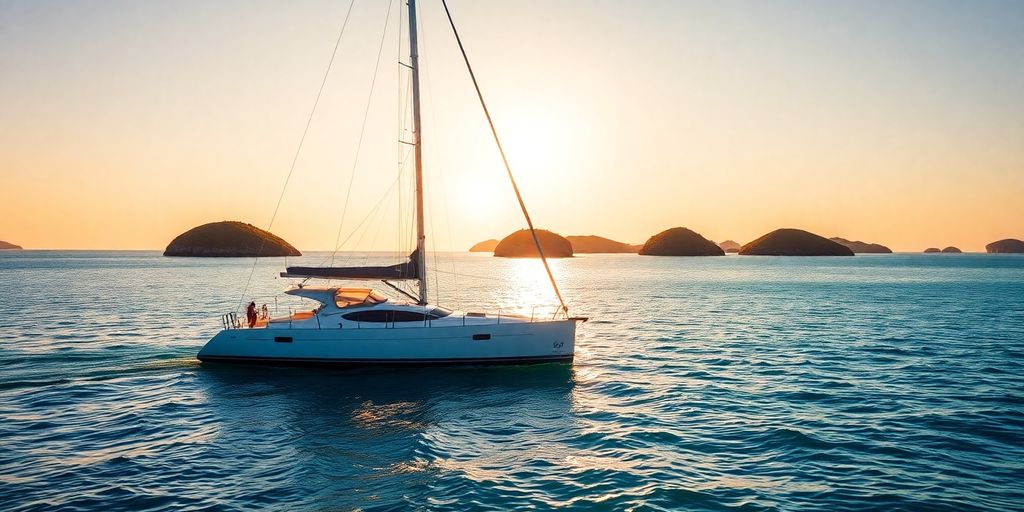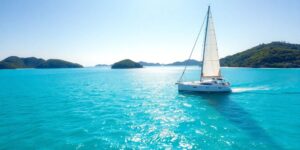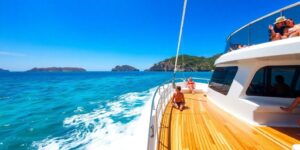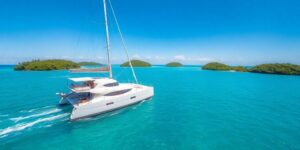Dreaming of a Caribbean sailing trip? It’s easy to picture clear blue water and sunny skies. But to make sure your trip is truly amazing, you need to plan things out. This guide will help you figure out the best time to sail in the Caribbean, so your adventure is everything you hoped for. We’ll cover everything you need to know to make your sailing trip perfect.
Key Takeaways
- The best time to sail in the Caribbean is generally from December to April, outside of hurricane season.
- Shoulder seasons (late April/early May and early December) offer good weather with fewer crowds and better prices.
- Planning your route carefully is important; the British Virgin Islands are great for beginners, while the Windward Islands offer more challenge.
- Be prepared for the tropical climate by packing sunscreen, hats, light clothes, and rain gear.
- Ensure your boat is well-equipped with safety gear, communication tools, and a first aid kit.
1. Time
Figuring out the best time to sail in the Caribbean isn’t just about the weather; it’s also about snagging the best deals and avoiding crowds. Timing is everything when it comes to booking your dream voyage.
Think of it like this: booking early often gets you better prices and cabin choices, but waiting for last-minute deals can sometimes pay off if you’re flexible. It’s a bit of a gamble, but knowing the trends can help you make an informed decision.
Here are a few things to keep in mind:
- Booking Windows: Cruise lines often release itineraries far in advance, sometimes up to 18 months. Booking early can give you the best selection of cabins and early-bird discounts.
- Seasonal Considerations: The Caribbean has peak seasons (like winter) and off-seasons (like summer/fall). Prices and crowds vary significantly depending on the time of year. Consider seasonal considerations when planning.
- Specialty Cruises: If you’re eyeing a themed cruise or one that coincides with a holiday, book well in advance. These tend to sell out quickly.
| Time of Year | Pros | Cons |
|---|---|---|
| Winter | Best weather, festive atmosphere | Higher prices, larger crowds |
| Spring | Pleasant weather, fewer crowds than winter | Potential for spring break disruptions |
| Summer | Lower prices, warmer waters | Hurricane season, hotter temperatures |
| Fall | Lowest prices, fewer crowds | Hurricane season, unpredictable weather |
For specialty cruises, like those around Valentine’s Day or Thanksgiving, aim to book 12-18 months ahead. This ensures you get the best options for cabin types and shore excursions. Also, if you’re planning a milestone celebration, early booking is key to securing the perfect arrangements for your group. Don’t forget to use a travel advisor to help you secure the best time to book.
2. Route
Okay, so you’re thinking about sailing the Caribbean? Awesome! But before you even start packing your bags, let’s talk about where you actually want to go. The Caribbean is HUGE, and the route you pick can totally make or break your trip. It’s not just about picking islands that look pretty on a postcard; it’s about thinking about what you want to do while you’re there.
Your route is a big deal because it dictates the kind of experience you’ll have.
Think about it: Do you want to hop from island to island every day, exploring new beaches and towns? Or are you more into chilling in secluded coves, snorkeling, and just generally taking it easy? Maybe you’re a history buff and want to check out some old forts and colonial architecture. Or perhaps you’re all about the nightlife and want to hit up some lively bars and clubs. All of these things will influence where you should go.
Here’s a few things to consider:
- Island Hopping vs. Staying Put: Some routes are designed for seeing as many islands as possible. Others focus on a smaller area, letting you really get to know a few spots.
- Prevailing Winds and Currents: This is a big one for sailors. You want to make sure you’re not constantly fighting the wind. Some routes are naturally easier to sail than others. Consider the best time to sail for optimal conditions.
- Your Skill Level: If you’re a newbie sailor, you might want to stick to calmer waters and shorter distances between islands. More experienced sailors can tackle more challenging routes.
Don’t be afraid to do some research and talk to other sailors or charter companies. They can give you some great insights and help you plan a route that’s perfect for you. Also, think about what kind of boat you’ll be using. A smaller sailboat might be great for exploring shallow waters, while a larger catamaran might be better for longer passages.
3. Regulations
Sailing in the Caribbean is awesome, but it’s not a free-for-all. Each island has its own set of rules, and you gotta know them before you go. Think of it like this: you wouldn’t just walk into someone’s house without knocking, right? Same deal here.
Understanding and respecting local regulations is key to a smooth and enjoyable sailing experience.
Ignoring these rules can lead to fines, delays, or even being denied entry. Nobody wants that ruining their vacation.
Here’s what you need to keep in mind:
- Cruising Permits: Many islands, like the British Virgin Islands, require cruising permits. Get these sorted out ahead of time. It’s not just paperwork; it’s your ticket to avoid trouble.
- Marine Protected Areas (MPAs): Lots of areas are protected to keep the coral reefs and other ecosystems safe. Anchoring might be restricted or totally off-limits. Look for designated mooring spots. Don’t be that person who damages the reef.
- Local Customs: The Caribbean is a melting pot of cultures. Each island has its own vibe. Learn a few basic phrases, be respectful of traditions, and you’ll be welcomed with open arms. It’s about more than just seeing the sights; it’s about connecting with the people. For example, when planning sailing holidays in Guadeloupe, it’s good to know a few French phrases.
4. Climate

Okay, so you’re thinking about sailing the Caribbean? Smart move! But before you pack your bags and dream of turquoise waters, let’s talk climate. It’s not always sunshine and rainbows, though it’s pretty close most of the time. Understanding the weather patterns can really make or break your trip.
The Caribbean generally enjoys warm, tropical weather year-round, but there are definitely seasons to be aware of.
Here’s a quick rundown:
- Dry Season (December to May): This is generally considered the best time to visit. You’ll find less rain, lower humidity, and plenty of sunshine. Perfect for sailing!
- Hurricane Season (June to November): This is when things get a bit dicey. While you might find lower prices, you also run the risk of storms. Keep an eye on the forecast and consider travel insurance.
- Shoulder Seasons (April-May & November): These can be great times to visit. You’ll often find a sweet spot between good weather and fewer crowds.
It’s worth noting that even during the rainy season, it doesn’t usually rain all day, every day. You might get a quick downpour in the afternoon, but then the sun comes back out. Still, it’s something to keep in mind when planning your trip.
To help you visualize, here’s a simplified table:
| Season | Months | Temperature (°F) | Rainfall | Humidity | Notes |
|---|---|---|---|---|---|
| Dry Season | Dec – May | 75-85 | Low | Low | Best time to sail |
| Hurricane Season | Jun – Nov | 80-90 | High | High | Risk of storms, lower prices |
| Shoulder Season | Apr-May & Nov | 78-88 | Moderate | Moderate | Good weather, fewer crowds than peak |
Don’t forget to check the specific forecast for the islands you plan to visit, as conditions can vary across the Caribbean. Also, consider the best time to book your trip to get the best deals!
5. Boat
Choosing the right boat is a big deal when planning your Caribbean sailing trip. It’s not just about getting from point A to point B; it’s about comfort, safety, and how much you enjoy the journey. Think about what kind of experience you’re after and pick a boat that fits.
Size and Type
First off, how many people are coming? A cozy sailboat might be perfect for a couple, but a bigger group will need something with more space. Catamarans are super popular for their stability and roominess, making them great for families or groups. Monohulls are classic and can be more fun to sail if you’re into that. Consider the pros and cons of each.
Condition and Equipment
Don’t skip checking the boat’s condition. A well-maintained boat is way less likely to give you headaches on the water. Make sure all the important stuff like the engine, sails, and navigation gear are in good shape. Also, think about what equipment you’ll need. Do you want air conditioning? A generator? A good sound system? These things can make a big difference in your comfort.
Charter or Own
Are you thinking about chartering a boat, or buying one? Chartering is great if you only sail now and then. You get a well-equipped boat without the hassle of maintenance. But if you’re a serious sailor, owning a boat might make more sense. You can customize it how you like and sail whenever you want. For those considering a yacht charter, there are many options available to suit different needs and preferences.
It’s easy to get caught up in the excitement of planning a sailing trip, but don’t rush the boat selection process. Take your time, do your research, and choose a boat that fits your needs and budget. A little extra effort upfront can make a huge difference in how much you enjoy your time on the water.
Budget
Of course, you need to think about your budget. Boat prices can vary a lot depending on size, type, and condition. Don’t just look at the initial cost; factor in things like fuel, dockage fees, and maintenance. It’s better to be realistic about your budget than to end up with a boat you can’t afford to keep up.
6. Cruises
Cruises in the Caribbean? Yeah, that’s a big topic. It’s not just about hopping on a boat; it’s about finding the right cruise for you. There are a ton of options, and the time of year can seriously impact your experience. Let’s break it down.
Think about what you want from your cruise. Are you looking for a party atmosphere, a relaxing getaway, or an adventure-filled exploration? Your answer will help narrow down your choices.
Here’s a few things to consider:
- Type of Cruise: Big ship, small ship, sailing cruise, themed cruise – the options are endless. Each offers a different vibe and caters to different interests.
- Itinerary: Where do you want to go? Eastern Caribbean, Western Caribbean, Southern Caribbean? Each region has its own unique charm and attractions. Consider the hurricane season when planning.
- Budget: Cruise prices can vary wildly depending on the time of year, the length of the cruise, and the type of cabin. Set a budget and stick to it.
Timing is everything when it comes to cruises. Specialty cruises, like those around Valentine’s Day or Thanksgiving, often require booking well in advance. Don’t wait until the last minute, or you might miss out!
Here’s a simple table showing how prices can fluctuate:
| Month | Average Price (7-day cruise) |
|---|---|
| January | $1200 |
| June | $1500 |
| September | $900 |
| December | $1800 |
7. Prices
Planning a Caribbean sailing trip? Let’s talk money. It’s not just about the initial cost; it’s about understanding all the factors that influence what you’ll actually pay. Prices can swing wildly depending on when you go, what kind of boat you charter, and even how far in advance you book.
The time of year is the biggest factor in determining the price of your Caribbean sailing adventure.
Here’s a quick rundown of things that impact the price:
- Seasonality: High season (December to April) means higher prices. Shoulder seasons (May-June, Sept-Oct) offer a sweet spot.
- Boat Type: A luxury catamaran will cost more than a basic sailboat.
- Booking Time: Booking well in advance can sometimes snag you early bird discounts, but last-minute deals can also pop up.
- Duration: Longer trips obviously cost more, but sometimes the per-day rate decreases with longer charters.
It’s worth remembering that the cheapest option isn’t always the best. Consider what’s included in the price. Does it cover fuel, dockage fees, or a captain and crew? These extras can add up quickly, so factor them into your budget.
To get the best deals, keep an eye out for wave season deals from January to March. This is when cruise lines and charter companies roll out some of their best promotions. Also, be flexible with your dates. Even shifting your trip by a week or two can sometimes make a big difference in price.
Here’s a sample price comparison (these are just estimates, of course!):
| Boat Type | High Season (per week) | Shoulder Season (per week) | Off-Season (per week) |
|---|---|---|---|
| Small Sailboat | $3,500 | $2,800 | $2,100 |
| Mid-Size Catamaran | $8,000 | $6,500 | $5,000 |
| Luxury Yacht | $20,000+ | $16,000+ | $12,000+ |
8. Promotions
Okay, let’s talk about the good stuff: saving some cash! Who doesn’t love a good deal, right? When it comes to Caribbean sailing, keeping an eye out for promotions can seriously cut down on your overall costs. It’s not just about finding the cheapest cruise; it’s about getting the most bang for your buck.
Here’s the deal:
- Early Bird Specials: Booking way in advance can sometimes snag you a sweet discount. Think months, even a year ahead. It feels like forever, but your wallet will thank you.
- Last-Minute Deals: On the flip side, if you’re flexible and ready to pack your bags at a moment’s notice, last-minute deals can be amazing. Cruise lines want to fill those empty cabins!
- Seasonal Sales: Keep an eye out for sales around holidays or during the shoulder seasons (that’s the time between peak and off-peak). You might find some hidden gems.
Don’t forget to sign up for email lists from cruise lines and travel agencies. They often send out exclusive promotions to their subscribers. It’s a little extra clutter in your inbox, but it could save you a bundle. Also, consider using a travel advisor to help you find the best deals.
And remember, the listed price isn’t always the final price. Look for promotions that include extras like drink packages, shore excursions, or onboard credit. These can add up quickly, so getting them included can make a big difference. Always read the fine print to understand what’s included and what’s not.
Here’s a quick look at some common types of cruise promotions:
| Promotion Type | Description the best time to sail in the Caribbean depends on what you’re looking for. If you want to avoid crowds and save money, the shoulder seasons (April-May and September-October) are your best bet. If you’re looking for the best weather, December-April is ideal. And if you’re a thrill-seeker, hurricane season (June-November) might be for you (but be prepared for potential disruptions!).
9. Season
Okay, so when’s the actual best time to set sail? It really depends on what you’re looking for. Are you trying to dodge crowds? Snag a deal? Or are you all about that perfect weather window?
Shoulder Season Sweet Spot
Honestly, the shoulder seasons (April-May and September-October) are often your best bet. You’ll usually find a good balance of decent weather and fewer tourists. Plus, prices tend to be a bit lower than during peak season. It’s a win-win, really.
Peak Season Perks (and Problems)
December to March is peak season. Think sunshine, clear skies, and bustling ports. The downside? Higher prices and more people everywhere. If you’re okay with that, then go for it! Just book well in advance.
Hurricane Season Considerations
Hurricane season officially runs from June 1st to November 30th. September and October are historically the most active months. You can find some seriously discounted Caribbean cruises during this time, but you’re also taking a risk. Travel insurance is a must if you decide to sail then.
Weather by Month (Rough Guide)
| Month | Weather | Crowds | Prices |
|---|---|---|---|
| December | Sunny, dry | High | High |
| January | Sunny, dry | High | High |
| February | Sunny, dry | High | High |
| March | Sunny, dry | High | High |
| April | Warm, less humid | Moderate | Moderate |
| May | Warm, increasing humidity | Moderate | Moderate |
| June | Hot, humid, occasional rain | Lower | Lower |
| July | Hot, humid, potential for storms | Lower | Lower |
| August | Hot, humid, potential for storms | Lower | Lower |
| September | Hot, humid, peak of hurricane season | Lowest | Lowest |
| October | Warm, humid, hurricane season continues | Lowest | Lowest |
| November | Warm, less humid | Moderate | Moderate |
Ultimately, the best season depends on your priorities. If you’re flexible and willing to take a chance, you can score some amazing deals during the off-season. If you want guaranteed sunshine and calm seas, be prepared to pay a premium and share the experience with more people.
10. Advisor

Planning a Caribbean sailing trip involves a lot, and sometimes it’s just easier to get some help. That’s where a travel advisor comes in. They can really simplify the whole process and make sure you don’t miss anything important.
Why Use an Advisor?
- They know the deals: Travel advisors often have access to exclusive offers and promotions that you might not find on your own. They can save you money and get you extra perks.
- They handle the details: From booking flights to arranging accommodations, advisors take care of all the logistics. This frees you up to focus on the fun parts of planning your trip.
- They offer personalized advice: A good advisor will listen to your preferences and create a customized itinerary that fits your needs and budget. They can suggest hidden gems and activities you might not have considered.
A travel advisor can be your best friend when planning a sailing trip. They bring experience and insights that can make the difference between a good vacation and an amazing one. They can also help you navigate unexpected issues, like weather delays or itinerary changes.
Finding the Right Advisor
- Look for experience: Find an advisor who specializes in Caribbean travel and has a proven track record of successful sailing trips.
- Read reviews: Check online reviews and testimonials to see what other travelers have to say about their experiences with different advisors.
- Ask for referrals: Talk to friends and family who have used travel advisors in the past and ask for their recommendations.
What to Expect
When you work with a travel advisor, be prepared to discuss your budget, travel dates, and preferences. The advisor will then research different options and present you with a customized itinerary. They’ll handle all the bookings and arrangements, and they’ll be available to answer any questions you have along the way. Think of them as your personal travel concierge, making sure everything goes smoothly from start to finish. It’s like having a Caribbean sailing lessons expert in your corner!
Conclusion: Your Adventure Awaits
So, sailing the Caribbean isn’t just some regular trip; it’s a real adventure. You gotta plan things out, be cool with nature and the local vibe, and just be ready for anything. Whether you’re on a BVI catamaran or exploring further south, these islands will show you their magic if you’re ready for it. Get ready, be nice to the locals, stay safe, and roll with the punches the sea throws at you. That’s how you really get the most out of this amazing place. Every wave, every island, every sunset is part of your story. Yeah, there will be tough spots, but those are the parts you’ll remember. The Caribbean is calling. So, sail smart, stay safe, and just go for it. This trip will stick with you forever.
Frequently Asked Questions
When is the best time to go sailing in the Caribbean?
The best time to sail in the Caribbean is usually from December to April. During these months, the weather is sunny, the winds are steady, and the seas are calm. This period also avoids hurricane season, which runs from June to November. While it can be more crowded, the conditions are ideal for a smooth trip.
Can I sail in the Caribbean during less busy times?
Yes, you can sail in the Caribbean during the ‘shoulder seasons,’ which are late April to May and early December. The weather is still good, and there are fewer people around. Just keep an eye on weather forecasts, as there’s a small chance of storms, but many find the quieter experience worth it.
Which Caribbean islands are best for sailing, depending on my experience?
The British Virgin Islands (BVI) are great for beginners because they have calm waters and many safe places to anchor. For more experienced sailors, the Windward Islands (like St. Lucia or Grenada) offer more challenging winds and a more rugged adventure. Always pick a route that matches your sailing skills.
What should I pack for a sailing trip in the Caribbean?
It’s super important to pack sunscreen (high SPF!), a wide-brimmed hat, sunglasses, and light, airy clothes. Also, bring a lightweight rain jacket for sudden showers and waterproof bags to keep your things dry. And don’t forget to drink lots of water to stay hydrated!
What essential items should my boat have before I start my trip?
Before you leave, make sure your boat has a full first-aid kit, a toolkit for repairs, and reliable ways to communicate, like a VHF radio or satellite phone. Having snorkeling gear is also a must to explore the amazing underwater world!
Do I need to know about local rules when sailing between islands?
Yes, each island has its own rules about coming ashore, where you can anchor, and protecting the environment. It’s smart to check these rules before you arrive to make sure your trip goes smoothly and respectfully.



